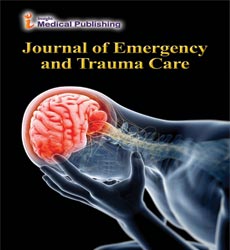Analgesia for Blunt Thoracic Trauma
Jennifer lusia*
Department of Trauma, University of Pretoria, Pretoria, South Africa
- *Corresponding Author:
- Jennifer lusia
Department of Trauma, University of Pretoria, Pretoria, South Africa
E-mail: jenniferlusia@pr.sa
Received Date: September 3, 2021; Accepted Date: September 17, 2021; Published Date: September 24, 2021
Citation: Lusia J (2021) Analgesia for lunt Thoracic Trauma. J Emerg Trauma Care Vol.6 No.1:25.
Editorial
Thoracic trauma is the second most prevalent nonintentional injury in the United States and is associated with significant morbidity. Analgesia for blunt thoracic trauma was first addressed by the Eastern Association for the Surgery of Trauma (EAST) with a practice management guideline published in 2005. Since that time, it was hypothesized that there have been advances in the analgesic management for blunt thoracic trauma. As a result, updated guidelines for this topic using the GRADE (Grading of Recommendations, Assessment, Development, and Evaluation) framework recently adopted by EAST are presented.
In 2005, the Eastern Association for the Surgery of Trauma (EAST) published a pain management guideline for blunt thoracic trauma. The authors of this review recognized the paucity of literature regarding the effectiveness of various analgesic modalities, and recommendations at the time reflected the most reasonable and likely approach to ensure positive outcomes. While several modalities were reviewed, the authors concluded that epidural analgesia is the preferred technique. This recommendation was challenged by Carrier et al. in a 2009 systematic review and meta-analysis and more recently by Duch and Møller. In adults with blunt thoracic trauma, the ideal analgesic modality remains uncertain.
Thoracic paravertebral blockade produces unilateral segmental somatic and sympathetic nerve blockade. In thoracic paravertebral blockade, in the paravertebral space, which contains spinal nerves and preganglionic and postganglionic sympathetic nerves, local anesthetics are injected as a singleshot procedure or with placement of a catheter for a continuous block. Thoracic paravertebral blocks are technically easier to perform than epidural analgesia, require less nursing surveillance, and have fewer absolute contraindications. The use of thoracic paravertebral blocks in patients with blunt thoracic trauma is not as well studied as epidural analgesia, and the effectiveness of this technique has not been subjected to the scrutiny of large clinical trials. However, with the proliferation of ultrasound, thoracic paravertebral blockade may become a desirable technique.
The goal of this article, which was sponsored by the EAST and cosponsored by the Trauma Anaesthesiology Society, is to provide updated evidence-based recommendations that may be used to direct the decision-making processes related to the care of patients with blunt thoracic trauma. This guideline has been developed using the Grading of Recommendations, Assessment, Development, and Evaluations (GRADE) framework adopted by EAST.
Although the quality and quantity of evidence for the use of multimodal analgesia in adult patients with blunt thoracic trauma are very limited, we conditionally recommend this modality. This recommendation is based on very low-quality evidence but places a high value on patient preferences for analgesia. There is some indirect evidence that multiple analgesic modalities (i.e., transdermal fentanyl, NSAIDs), when combined, decrease pain in patients with blunt thoracic trauma. Use of alternative agents for patients with refractory pain is consistent with the clinical experience of the group, as patients often seek alternatives when a standard sole opioid regimen fails. Moreover, standard sole opioid regimens are often associated with adverse effects, especially as doses are escalated, thus requiring consideration for additional nonopioid analgesics.
In summary, we propose two evidence-based recommendations regarding analgesia for patients with blunt thoracic trauma. In adult patients with blunt thoracic trauma, we conditionally recommend the use of epidural analgesia and multimodal analgesia versus opioids alone to treat pain.
Open Access Journals
- Aquaculture & Veterinary Science
- Chemistry & Chemical Sciences
- Clinical Sciences
- Engineering
- General Science
- Genetics & Molecular Biology
- Health Care & Nursing
- Immunology & Microbiology
- Materials Science
- Mathematics & Physics
- Medical Sciences
- Neurology & Psychiatry
- Oncology & Cancer Science
- Pharmaceutical Sciences
